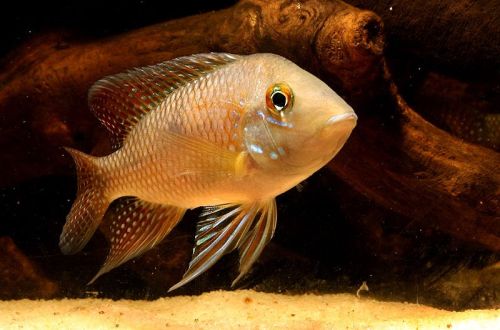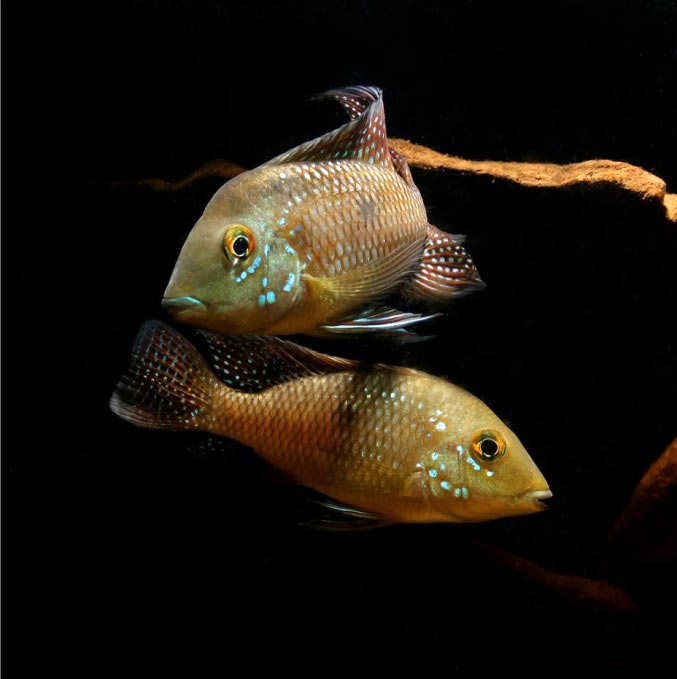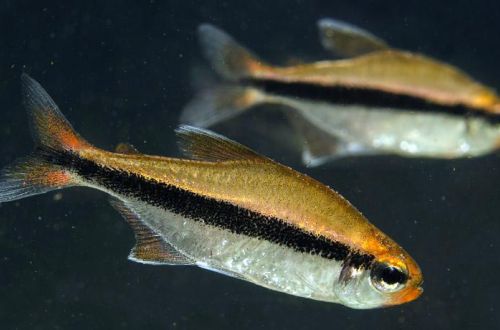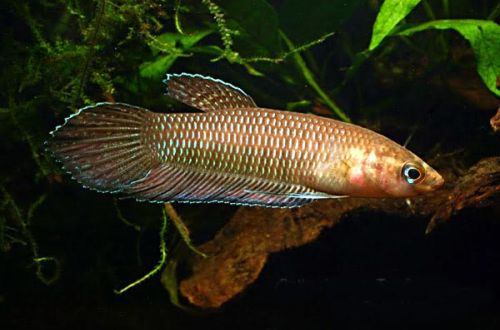
Geophagus Iporanga
Geophagus Iporanga, scientific name Geophagus iporangensis, belongs to the family Cichlidae (Cichlid). The fish is named after the area where it was first discovered – the municipality of Iporanga, the state of São Paulo, Brazil. Easy to keep and breed, perfectly compatible with other freshwater fish. Despite this, it is a rare guest in home aquariums.

Contents
Habitat
They come from South America from the basin of the Rio de Ribeira Iguape (Rio Ribeira de Iguape) in the southern part of the Brazilian state of Sao Paulo, just south of the city of the same name. Most of the length of the river passes through the rainforest, so in its channel there is a lot of plant organic matter: leaves, roots, tree branches. As a result of decomposition, tannins are released, giving the water a brown tint. Fish prefer shaded sections of rivers with sandy substrates and snag shelters.
Brief information:
- The volume of the aquarium – from 100 liters.
- Temperature – 20-26°C
- Value pH — 6.0–7.0
- Water hardness – 1–10 dGH
- Substrate type – sandy
- Lighting – subdued
- Brackish water – no
- Water movement is weak
- The size of the fish is up to 10 cm.
- Food – any sinking food
- Temperament – peaceful
- Content in a group of at least 5–8 individuals
Description

Adult males reach a length of 9–10 cm, females 6–8. In addition to size, dominant alpha males may develop a nuchal hump. The body color is light brown with rare blue speckles, the number of which increases significantly on the dark red fins and tail.
Food
An omnivorous species, it feeds mainly in the bottom layer. Unlike their relatives, other Geophagus, who sift portions of soil with their mouths in search of small invertebrates, for Geophagus Iporanga this is not the main way of feeding. They accept most sinking foods, such as dry flakes, pellets in combination with frozen brine shrimp, daphnia, bloodworm pieces.
Maintenance and care, arrangement of the aquarium
The optimal size of the aquarium for a group of 5-8 fish starts from 100 liters. The most important design element is the ground. It is recommended to use a sandy substrate to avoid eating problems (see above). Several large smooth stones will serve as a place for future spawning, and various snags will serve as a place where the fish can hide for a while. The lighting is subdued. The presence of aquatic plants is not necessary, but if desired, several unpretentious shade-loving species can be planted.
This type of cichlid is very sensitive to water quality deterioration – the accumulation of products of the nitrogen cycle, fluctuations in temperature and hydrochemical values. It is necessary to ensure stable water conditions. The best way to achieve this goal is to install a productive filtration system along with regular aquarium maintenance. The latter include: weekly replacement of part of the water (about 50% of the volume) with fresh water, removal of organic waste (food leftovers, excrement), equipment maintenance, etc.
Behavior and Compatibility
During the spawning period, the male becomes territorial, protecting the area at the bottom of the aquarium and the fry from potential danger. Otherwise, Geophagus Iporanga is quite friendly and able to get along with many non-aggressive fish species of comparable and smaller sizes. Intraspecific relationships are built on a hierarchy of alpha males over other relatives, while subdominant individuals do not experience any attacks from stronger brothers when they are in a group of 5–8 fish. With a smaller amount and in a small aquarium, some problems are possible.
Breeding / breeding
Under suitable conditions and a good diet, fish are able to come into a spawning state. With the onset of the mating season, the alpha male and one of the females form a temporary pair, which, however, sometimes persists for a long time. Fish choose a place for themselves at the bottom of the aquarium to create masonry. Usually this is any flat surface – a stone, a piece of driftwood, etc. At the end of spawning, the female remains in close proximity to the eggs to protect them. The male is a little further away, guarding the boundaries of his territory. After the fry appear, the parents continue to take care of their offspring for some time, until they become large enough.
Fish diseases
The main cause of diseases lies in the conditions of detention, if they go beyond the permissible range, then immunity suppression inevitably occurs and the fish becomes susceptible to various infections that are inevitably present in the environment. If the first suspicions arise that the fish is sick, the first step is to check the water parameters and the presence of dangerous concentrations of nitrogen cycle products. Restoration of normal/suitable conditions often promotes healing. However, in some cases, medical treatment is indispensable. Read more about symptoms and treatments in the Aquarium Fish Diseases section.





